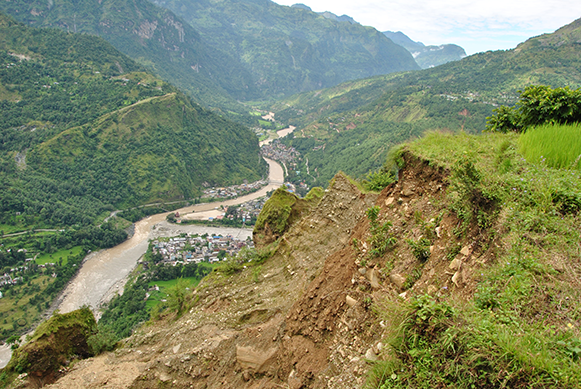GFZ team travels to the affected region
28.05.2015: Today a team of scientists from the GFZ German Research Centre for Geosciences departs for Nepal to investigate the aftereffects of the disastrous earthquakes in Nepal on 25th April and 12th May 2015. The work will focus, in particular, on the lingering danger due to landsliding, since such events cumulate in the weeks and months after the earthquakes. The efforts of the GFZ “Hazard and Risk Team” (HART) will concentrate on the affected regions north of Kathmandu, targeting the river catchments of the Buddhi Khola, the Trisuli and the Sun Koshi. Regular measurements are planned for the coming one and a half years with the help of local partners.
Strong earthquakes have direct effects such as the triggering of rock falls, collapse of buildings, or landslides. But there are a number of indirect effects that can remain active for months to years after the event. Earthquakes destabilize the landscape, loosen the soil, and cause cracking in bedrock. These can promote additional landslides and rockfall. Through the new cracks water can move through the sub surface, lubricating the bedrock-soil interface, and thus help the downwards motion of material especially during heavy rain. At the same time, water can reach river channels quicker, and thus the risk of flooding can increase.
Over several months to years, depending on weather, the type of local bedrock, and the strength of the earthquake, these effects return to the pre-quake status. Cracks slowly close, or are filled by sand and soil. The aim of the GFZ research campaign is to study the underlying mechanisms and, in this way, to be ultimately able to provide better hazard and risk evaluations. The scientists will install 12 seismometers, six weather stations and up to 15 hydrological stations.
The work is coordinated by the GFZ and part of an international network including scientists from Nancy, Zurich, Cambridge, Edinburgh, Utrecht and Nepal.








![[Translate to English:] Torsten Sachs in front of a climate station on a field](/fileadmin/_processed_/3/9/csm__TorstenSachs_bearbeitet_GS_4a1365ef84.jpeg)

![[Translate to English:] left image flood at the Ahrtal: image from above, several houses are flooded; left image:: Heidi Kreibich;](/fileadmin/_processed_/4/4/csm_Bild2_9af0130e9f.png)



![[Translate to English:] Start der Vega Rakete](/fileadmin/_processed_/6/4/csm_20231201-kachel_Vega-VV23-launch_ESA-CNES-Arianespace_706716b68c.jpeg)









![[Translate to English:] Poster exhibition at the Brandenburg Hydrogen Day at the GFZ, some participants in the foreground](/fileadmin/_processed_/6/5/csm_Erster_Brandenburgischer_Wasserstofftag_GFZ_402fcec95e.jpeg)
![[Translate to English:] Group picture of the participants](/fileadmin/_processed_/9/4/csm_20231108_CAWa-Workshop-Tashkent_Gruppenbild_99ea779d8a.jpeg)

![[Translate to English:] [Translate to English:] Hörsaal](/fileadmin/_processed_/e/6/csm_H%C3%B6rsal_e21ac645fb.jpeg)


![[Translate to English:] The Delegations in the Historic Library on the Telegrafenberg. In the back there are from left to right, the Dutch Ambassador for Germany, Ronald van Roeden, the Dutch Minister for Education, Culture and Science, Robbert Dijkgraaf and the scientific director of the GFZ, Susanne Buiter.](/fileadmin/_processed_/d/b/csm_Kachel-2_9eba4b4212.jpeg)

